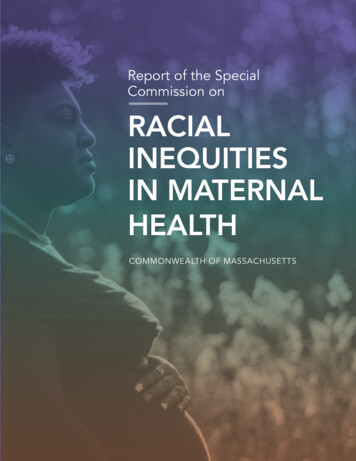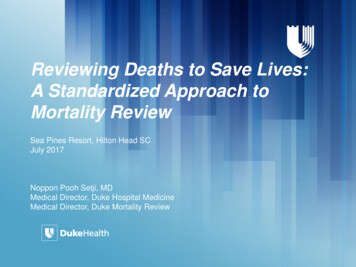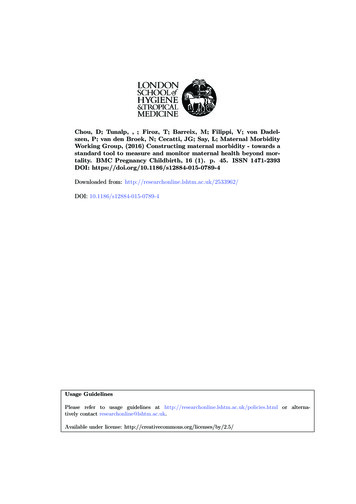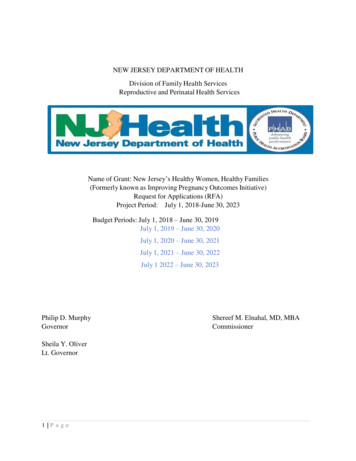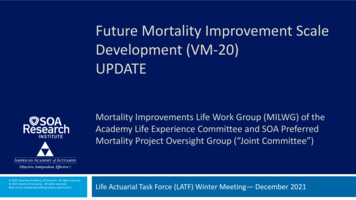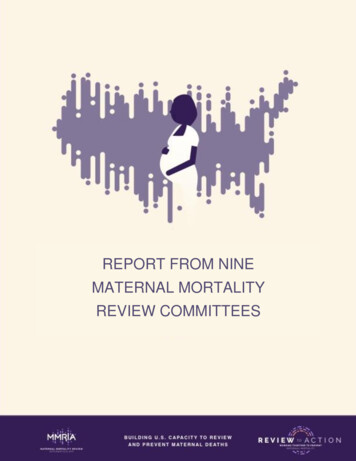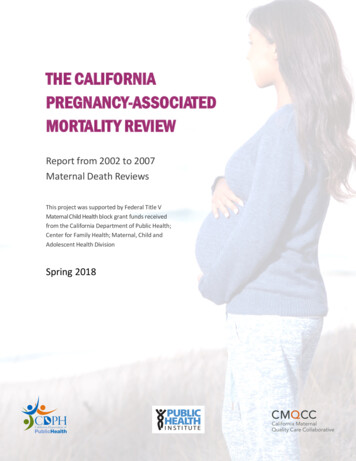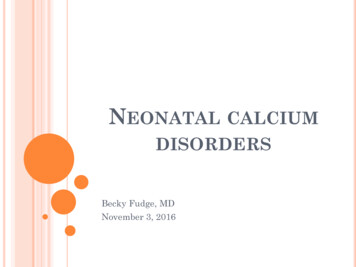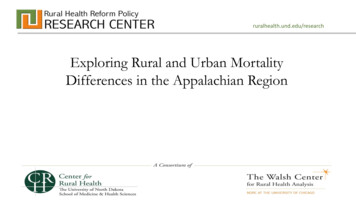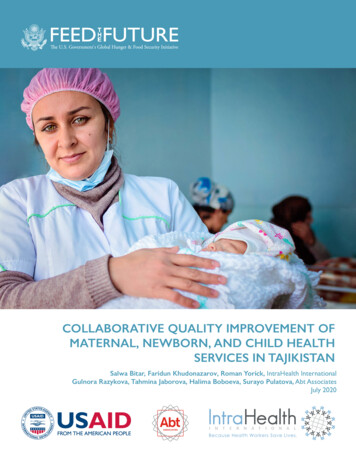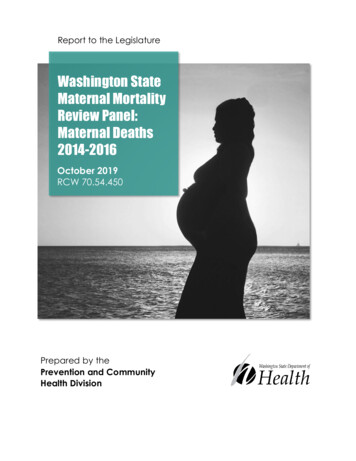
Transcription
Report to the LegislatureWashington StateMaternal MortalityReview Panel:Maternal Deaths2014-2016October 2019RCW 70.54.450Prepared by thePrevention and CommunityHealth Division
For persons with disabilities, this document is available in other formats.Please call 800-525-0127 (TTY 711) or email civil.rights@doh.wa.gov.Publication Number:141-010 October 2019For more information on this report contact:Prevention and Community Health DivisionOffice of Family and Community Health ImprovementPO Box 47880Olympia, Washington wa.govReport AuthorsOn behalf of the Washington State Maternal Mortality Review Panel:Victor AndinoAlexis Bates, MA, MSWTiffani Buck, WHNP-BC, MSN, MPHVictoria Lazariu, PhDJohn Wiesman, DrPHSecretary of HealthWASHINGTON STATE DEPARTMENT OF HEALTHWashington State Maternal Mortality Review Panel:Maternal Deaths 2014-2016 2
ContentsAcknowledgments . 5Executive Summary . 8Background . 10What does Maternal Mortality look like in the United States?. 10Have there been any changes to maternal mortality surveillance, nationally? . 10What is Washington doing to reduce maternal deaths? . 11Who is on the Maternal Mortality Review Panel? . 11What definitions does Washington use in the maternal mortality review? . 12How does the Panel conduct a maternal mortality review? . 13Why does this report include suicide and overdose deaths when they weren’t included inthe last report? . 14Findings . 14Maternal Mortality 2014-2016 . 16Pregnancy-Associated Deaths, 2014-2016 . 17Pregnancy-Related Deaths, 2014-2016 . 21Pregnancy-Associated Deaths Due to Behavioral Health Conditions . 27Pregnancy-Associated Deaths from Accidental Substance Overdose . 28Pregnancy-Associated Deaths from Suicide . 29Summary of Findings . 30What factors contributed to preventable pregnancy-related deaths? . 31Recommendations . 36Priority Recommendation 1. 37Priority Recommendation 2. 40Priority Recommendation 3. 42Priority Recommendation 4. 44Priority Recommendation 5. 46Priority Recommendation 6. 47What is the Department of Health doing to implement Recommendations? . 49Conclusion . 51Appendix 1: Review Process . 56WASHINGTON STATE DEPARTMENT OF HEALTHWashington State Maternal Mortality Review Panel:Maternal Deaths 2014-2016 3
Appendix 2: Additional Data & Findings . 59Pregnancy-related Deaths, Additional Data (N 30) . 61Pregnancy-related Deaths Due to Other Medical Causes (n 19) . 63Pregnancy-associated, not related deaths from other medical causes . 65Pregnancy-associated deaths due to other injuries . 66Appendix 3: Maternal Mortality Review Panel Committee Decisions Form . 68Appendix 4: RCW 70.54.450 . 72Appendix 5: Quality Improvement Updates. 75Appendix 6: An Early Look at 2017 Maternal Deaths . 77Appendix 7: Review of 2014-2016 Maternal Deaths Fact Sheet . 79WASHINGTON STATE DEPARTMENT OF HEALTHWashington State Maternal Mortality Review Panel:Maternal Deaths 2014-2016 4
AcknowledgmentsWe would like to acknowledge the women who died, the loved ones they left behind, and thepeople who cared for them. This work is done to prevent deaths and to improve the lives of allwomen, children, and families throughout Washington State. The maternal mortality reviewwould not be possible without the Maternal Mortality Review Panel and the women’s health andservice providers who volunteer their expertise, time, and service to improve women’s healthcare in Washington State.Panel MemberProfessional TitleOrganizationAlfred Seekamp, MD, MCHMOB-GYNThe Vancouver ClinicAmber Hudson, MSN/EdLabor and delivery nurse managerJefferson HealthcareAmritha Bhat, MD, MPHPsychiatryUniversity of WashingtonAmy Bertone, RN, BSNPerinatal Coordinator, RN, BSNProvidence Sacred Heart Medical CenterAngela Chien, MDOB-GYNEvergreenHealthAnna Klastorin, MSW, LICSWSocial ServicesUniversity of Washington Medical CenterApril Haugen, MSM, LMLicensed MidwifeSky Valley MidwiferyBarbara Juarez, PAPANW WA Indian Health BoardCalvin Wallace, MDOB-GYNMultiCare Health SystemCarl R. Olden, MDFamily medicine, obstetricsYakima Valley Memorial HospitalCarla Syverson, CNM, MN, MPHARNP Nurse MidwifeContractor to CDC, DRH, maternal mortality surveillanceCarol Salerno, MDOB-GYNUniversity of Washington Northwest HospitalCharissa Fotinos, MDDeputy Chief Medical OfficerWashington State Health Care AuthorityCindy Gamble, MPHTribal Community Health ConsultantAmerican Indian Health CommissionCorinne L. Fligner, MDPathologistProfessor Emeritus, University of WashingtonCynthia Flynn, CNM, PhDARNP Nurse MidwifeRetiredDale P Reisner, MDMaternal Fetal MedicineSwedish Health ServicesDebbie Raniero, MBA, RNCLabor and delivery nurse managerCHI Franciscan HealthDebra Sperling, BSN, RNC-OBLabor and delivery nurse managerNorthwest Hospital and Medical CenterDevon LovePublic and Community HealthEqual Start Community Coalition; Seattle-King County PHDouglas L Madsen, MDOB-GYNPeaceHealth St. Joseph Medical CenterElizabeth Pesek, MN, BSN, RNClinical Outcomes SpecialistOverlake HospitalEllen Kauffman, MDOB-GYNFoundation for Health Care QualityFred Coleman, MDMaternal Fetal MedicineLegacy Health System/Legacy Salmon Creek HospitalGina M Fino, MDPathologistWashington State Department of HealthH. Frank Andersen, MDOB-GYNElson S. Floyd College of Medicine, WA State UniversityHeather Bradford, CNM, ARNPARNP Nurse MidwifeEvergreenHealth Midwifery CareHongxiu Ji, MDPathologistIncyte Diagnostics and Overlake HospitalIan Bennett, MDFamily medicine, obstetricsUniversity of WashingtonWASHINGTON STATE DEPARTMENT OF HEALTHWashington State Maternal Mortality Review Panel:Maternal Deaths 2014-2016 5
Ian Wallace, MS, LCGCGenetic CounselorPullman Regional HospitalIleana Ponce Gonzalez, MDPublic HealthNon-profit Migrant Clinical NetworkIra Kantrowitz-Gordon, PhD, CNMARNP Nurse MidwifeUniversity of Washington School of NursingJane Hitti, MDMaternal Fetal MedicineUniversity of WashingtonJennifer Cerdena, PharmDPharmacistSt. Joseph Medical CenterJames Walsh, MDFamily medicine, obstetricsSwedish Addiction and Recovery ServicesJoseph Hwang, MDMaternal Fetal MedicineValley Medical Center Maternal Fetal MedicineJosie Sackmann, BSWSocial ServicesCardon OutreachJoy Chilcote, CNM, ARNP, MNARNP Nurse MidwifeProvidence Medical Group, EverettKaren E. Hays, CNM, ARNPARNP Nurse MidwifeAmerican College of Nurse-Midwives, WashingtonKathy Weed, MPADiversity and Inclusion CouncilWashington State Department of HealthLinda Licata, MS, ARNP, WHNPARNP, Service Line Director, QIPeace Health Southwest Medical CenterLisa Larkin, RN, DNP, CNMARNP Nurse MidwifeNorthwest Midwives, a division of Northwest OB/GYNLisa Stotts, LM, CPM, MSMLicensed MidwifeMidwives Association of Washington StateMargie Bridges, MN, ARNP, RNCPerinatal CNSOverlake Hospital Medical CenterMary Puttmann-Kostecka, MDFamily medicine, obstetricsSwedish Cherry Hill Family Medicine ResidencyMelissa Cate, RN, MN, MBACNS, Nursing administratorSwedish Medical CenterNeva Gerke, LM, CPM, MSMLicensed MidwifeMidwives Association Of Washington StateNeetha Mony, MSWInjury and Violence PreventionWashington State Department of HealthPatrick Marmion MD, MPHOB-GYNElson S. Floyd College of Medicine, WA State UniversityPatrick Moran, MDFamily medicine, obstetricsCommunity Health of Central WashingtonRaju A.T. Dahlstrom, MSWSocial ServicesAccelerated International Marketing StrategiesRichard Kubiniec, MDOB-GYNSeamar Community Health CenterRobin de Regt, MDMaternal Fetal MedicineEastside and Evergreen Maternal Fetal MedicineRob Reed, CNM, ARNP, IBCLCARNP Nurse MidwifeSwedish Medical CenterSarah M. Matthews, MSWSocial ServicesUniversity of Washington Medical Center (UWMC)Sarah Prager, MDOB-GYNUniversity of WashingtonSharon Muza, CD, BDT, LCCEDoula, Community MemberPrivate practiceTami Allen, MHA, BSN, RNCLabor and Delivery Nurse ManagerProvidence Regional Medical Center EverettThomas Benedetti, MD, MHAMaternal Fetal MedicineProfessor Emeritus, University of WashingtonThomas R Easterling, MDMaternal Fetal MedicineUniversity of WashingtonVania Rudolf, MD, MPHFamily medicine, obstetricsAddiction Recovery Services, Swedish Medical CenterVeronika Zantop, MDPsychiatrySwedish Center for Perinatal BondingVictoria Bennett, MSW, LICSWSocial ServicesMulticare Health System Tacoma and Mary Bridge NICUVivienne Souter, MDOB-GYNSwedish Medical Group; Providence Health and ServicesWASHINGTON STATE DEPARTMENT OF HEALTHWashington State Maternal Mortality Review Panel:Maternal Deaths 2014-2016 6
Contributors at the Washington State Department of HealthJohn Wiesman, DrPH, MPHSecretary of Health, Washington State Department of healthKathy Lofy, MDChief Health Officer, Office of the SecretaryCathy Wasserman, PhDState Epidemiologist, Non-Infectious DiseasesLacy Fehrenbach, MPHAssistant Secretary, Prevention and Community HealthAmy Sullivan, PhDSenior Epidemiologist of the Assistant SecretaryKatie Eilers, MPHDirector, Office of Family and Community Health ImprovementVictor AndinoCommunications Specialist, Center for Public AffairsJohn Tuttle-GatesDeputy Director, Office of Family and Community Health ImprovementCynthia Morrison, PhDFormer Unit Manager, Access, Systems and CoordinationTeresa Vollan, PhDSenior Epidemiologist, Surveillance and EvaluationKatie Hutchinson, PhD, MPHSenior Epidemiologist, Center for Health StatisticsRabeeha Ghaffar, MPHPerinatal Health Program ManagerTiffani Buck, WHNP-BC, MSN, MPHPerinatal and Maternal Nurse ConsultantVictoria Lazariu, PhD, MPHEpidemiologist, Center for Health StatisticsSwee Cripe, PhD, MPHMaternal Child Health EpidemiologistMary Chris Knutson, ARNPNurse AbstractorAlexis Bates, MSWMaternal Mortality Review Panel CoordinatorWASHINGTON STATE DEPARTMENT OF HEALTHWashington State Maternal Mortality Review Panel:Maternal Deaths 2014-2016 7
Executive SummaryThe Washington State Legislature established a Maternal Mortality Review Panel (the Panel)within the Department of Health (the Department) in 2016. The Panel was tasked with reviewingmaternal deaths within the state and producing a biennial report with findings andrecommendations to prevent future maternal deaths. The Panel’s first report, released in 2017,covered maternal deaths between 2014 and 2015.This report examines maternal deaths between 2014 and 2016 and includes data from thepreviously published report. The growing understanding of the complex role that behavioralhealth issues play in pregnancy led the Panel to examine maternal deaths from suicide andsubstance overdose for this report.Findings from the 2014-2016 maternal mortality reviews identified 100 pregnancy-associateddeaths in 2014-2016, which are deaths that occur during pregnancy or the first year afterpregnancy. As shown in Figure 1a, these data include deaths related to pregnancy, not related topregnancy, and those that can’t be determined if they are related to pregnancy (Figure 1a). Thirtyof these deaths were determined by the Panel to be pregnancy-related, which means the Paneldetermined that the death occurred during pregnancy or within the first year after pregnancyfrom a pregnancy complication, a chain of events initiated by pregnancy, or the aggravation ofan unrelated condition by the physiologic effects of pregnancy.Figure 1a: Key Definitions - Washington State Maternal Mortality Review PanelWASHINGTON STATE DEPARTMENT OF HEALTHWashington State Maternal Mortality Review Panel:Maternal Deaths 2014-2016 8
Key findings include: Maternal mortality rates in Washington are not increasing like they are nationally.The leading underlying cause of death among pregnancy-related deaths (N 30) werebehavioral health conditions, including suicide and overdose (30%), hemorrhage (20%)and hypertensive disorders in pregnancy (10%).The pregnancy-related death ratio was 11.2 deaths per 100,000 live birthsThe majority of pregnancy-related deaths occurred during pregnancy or delivery (30%),or within 42 days after the end of pregnancy (35%).The Panel concluded that 60% of the pregnancy-related deaths were preventable.Interpretations of the data presented in this report should be made with caution. While eachdeath is a tragedy, the cohort of maternal deaths for 2014-2016 is relatively small, and slightchanges could have resulted in very different percentages. Findings in this report are a snapshotof this three-year interval.The Panel identified the factors that contributed to each preventable pregnancy-related death.These are the events or issues that, if altered, the Panel believes might have prevented the death.Factors identified included access to health care services, gaps in continuity of care (especiallypostpartum), gaps in clinical skill and quality of care (including delays in diagnoses, treatment,referral, and transfer), and lack of care coordination at the provider, facility, and systems levels.The Panel used this information to make recommendations to prevent maternal deaths.Recommendations are:1. Address social determinants of health, structural racism, provider biases, and other socialinequities to reduce maternal mortality in priority populations.2. Support active engagement by birthing hospitals, licensed birth centers, and perinatalproviders in quality improvement efforts that reduce the leading causes of maternalmortality and morbidity.3. Ensure funding and access to postpartum care and support through the first year afterpregnancy for all pregnancy outcomes.4. Increase access and reduce barriers to behavioral health and community supportstructures from preconception through pregnancy and the first year postpartum.5. Increase and improve reimbursement for behavioral health care from preconceptionthrough all phases of pregnancy and the first year postpartum, including screening,treatment, monitoring, and support services.6. Increase knowledge and skill of providers, patients, and families about behavioral healthconditions during and after pregnancy, and the treatment and resources that areavailable for support.WASHINGTON STATE DEPARTMENT OF HEALTHWashington State Maternal Mortality Review Panel:Maternal Deaths 2014-2016 9
BackgroundWhat does Maternal Mortality look like in the United States?Maternal mortality in the United States affects hundreds of families each year. The PregnancyMortality Surveillance System (PMSS) at the Centers for Disease Control and Prevention (CDC)reports that rates of maternal mortality have been on the rise since the 1980s. Nationally,approximately 700 women die each year from complications related to pregnancy and childbirth. iCDC estimates that 60% of these deaths are preventable.iiRates of maternal mortality in the United States are higher than those in most other developednations.iii A patient’s race, income, and place of residence influence the quality of care shereceives.iv In addition to the women who die, as many as 60,000 more women suffer severecomplications related to pregnancy and childbirth. These women are often burdened withsignificant medical, economic, and social setbacks that are costly to families, communities, andsocial and health resources.vHave there been any changes to maternal mortality surveillance,nationally?The national picture of maternal mortality is difficult to understand because of variations in howstate and federal agencies monitor maternal mortality. The most notable variations are the termsused to define types of maternal deaths, the sources of records and data used to drawconclusions and outline trends in maternal mortality, and the scope of work in which maternalmortality reviews are conducted. St. Pierre, et al identify three main systems of maternalmortality surveillance in the United States.vi These systems are composed of the National VitalStatistics System and the Pregnancy Mortality Surveillance System at the federal level, and stateor local maternal mortality review committees or panels.vii Each system reports on differentinformation and data for varied purposes, and states may select any one of these systems toreport on maternal mortality. Because of this, comparability between states is limited, and statedata cannot necessarily be compared to federal maternal mortality surveillance systems.Findings from maternal mortality reviews result in the most accurate and comprehensive dataand insight into the issues affecting maternal mortality. In the last year, a number of states havepassed maternal mortality review legislation, and interest in establishing maternal mortalityreview panels continues to grow.viiiA partnership between the CDC, the Association of Maternal and Child Health Programs(AMCHP), and the CDC Foundation, has focused efforts to improve and standardize maternalmortality surveillance in the United States. The partnership between these entities has led to theBuilding U.S. Capacity to Review and Prevent Maternal Deaths initiative. The goal of the initiativeWASHINGTON STATE DEPARTMENT OF HEALTHWashington State Maternal Mortality Review Panel:Maternal Deaths 2014-2016 10
is to increase the use of maternal mortality review panels or committees by individual states todevelop a more comprehensive understanding of maternal mortality across the country.ix Theinitiative is giving participating states tools and technical assistance on the use of those tools.Ideally, this initiative will result in increased use of maternal mortality reviews for surveillance byindividual states and make comparisons between states easier and more accurate. This will helpstakeholders and advocates save lives by focusing prevention activities to improve maternal carefor women across the country.What is Washington doing to reduce maternal deaths?The Department has studied maternal mortality since 1990, and for more than 25 years datacollected from birth and death certificates have been analyzed to understand Washington trends.Rates of maternal mortality in the state are relatively stable, and seem to be lower than thenational average cited by the Pregnancy Mortality Surveillance System in 2018. However, before2016 the maternal mortality reviews in Washington State had limited staffing, funding, andaccess to pertinent records, which made it difficult for experts to determine which deaths werepreventable and what factors were contributing to the deaths.In 2016, the Washington State Legislature passed Engrossed Second Substitute Senate Bill 6534to establish an official Maternal Mortality Review Panel.x The law directs the Panel to: Review maternal deaths in the state and determine if deaths are related to pregnancy;Identify factors contributing to those deaths;Make recommendations for systems changes to improve health care services for women;Submit a report of findings to the health care committees of the House of Representativesand Senate every two years.The law gives the Department the authority to obtain pertinent vital records, medical records,and autopsy reports related to maternal deaths. The law also provides protections for thoserecords and for the panel members who participate in the review. This authority and protectionallowed the Department and the Panel to determine which deaths were preventable and identifythe issues that lead to preventable deaths. The law was amended in 2019 to permanentlyestablish the Panel and the maternal mortality review in Washington.Who is on the Maternal Mortality Review Panel?The Washington State Maternal Mortality Review Panel (the Panel) is made up of more than 60health and service professionals from diverse backgrounds who live and work throughout thestate. Panel members are appointed by the Secretary of Health and voluntarily serve on the panelfor three to five years. Panel members must adhere to strict confidentiality rules and have noaccess to any identifiable information. They are presented with de-identified summaries of eachWASHINGTON STATE DEPARTMENT OF HEALTHWashington State Maternal Mortality Review Panel:Maternal Deaths 2014-2016 11
reviewed death, de-identified data, and aggregated data to conduct the review. They use thisinformation to make key decisions to meet the goals and objectives of the review. Panel membersare listed in the Acknowledgements.What definitions does Washington use in the maternal mortality review?In Washington, the four key definitions used in the maternal mortality review are those publishedby the CDC Foundation.xiA pregnancy-associated death is the death of a woman during pregnancy or within the first yearafter the end of her pregnancy from any cause (see Figure 1b). This term encompasses deaths thatare pregnancy-related, deaths that are pregnancy-associated but not related, and deaths thatcannot be determined if they are related to pregnancy. The term “pregnancy-associated death” issynonymous with maternal death in this report.Figure 1b: Key Definitions - Washington State Maternal Mortality Review PanelWASHINGTON STATE DEPARTMENT OF HEALTHWashington State Maternal Mortality Review Panel:Maternal Deaths 2014-2016 12
After the review process is complete, each pregnancy-associated death is categorized into oneof three sub-categories, including (see Figure 1b): Pregnancy-related deathPregnancy-associated not related death, orUnable to determine pregnancy-relatednessAs part of the review process, the Panel works to determine which pregnancy-related deathswere preventable using the definition outlined in RCW (see Appendix 4).How does the Panel conduct a maternal mortality review?The Department and the Panel conduct the maternal mortality reviews through a multi-levelprocess that is grounded in a maternal mortality review framework developed by the BuildingU.S. Capacity to Review and Prevent Maternal Deaths initiativexii. This framework provides bestpractices and guidelines for reviewing pregnancy-associated deaths to determine pregnancyrelatedness, preventability, contributing factors to deaths, and opportunities for interventions.Additionally, the process is easily applied to all type of deaths, including deaths related tobehavioral health conditions.The process begins with the Department’s Center for Health Statistics working to identifymaternal deaths in the state within a given time period and ends with the development of Panelfindings and recommendations for legislators, including prevention activities (see Figure 2). With theexception of deaths related to homicide, each pregnancy-associated death is reviewed to determinewhether it is pregnancy-related. If a death is pregnancy-related, the Panel determines if it waspreventable, identifies contributing factors in the death, and makes recommendations onprevention. This process is outlined by the CDC Foundation (see Appendix 3). After qualitative andquantitative analyses of the review findings are completed, the Panel and the Departmentdevelop systems-level recommendations to improve maternal care based on the findings of thematernal mortality review. These are submitted to state legislators in a report due every three yearsin accordance with legislation revisions in 2019. For more details, see Appendix 1.Figure 2: Multi-level Review Process, Washington StateLevel 1 Review:Identification ofPregnancy-AssociatedDeathsLevel 2 Review:Categorization andAbstractionLevel 3 Review:Pregnancy-RelatedMortality Reviewand PreventabilityDiscussionWASHINGTON STATE DEPARTMENT OF HEALTHWashington State Maternal Mortality Review Panel:Maternal Deaths 2014-2016Level 4 Review:Systems-LevelRecommendationDevelopment 13
Why does this report include suicide and overdose deaths when theyweren’t included in the last report?Feedback from members of the Panel and key partners indicated a strong desire for Washington’smaternal mortality review to acknowledge the magnitude of suicide and overdose deaths onmaternal mortality. This is in large part due to a national paradigm shift in how mood disorders,suicide, and substance use are understood in relation to pregnancy. Contributing to this shift isthe growing body of knowledge around behavioral health issues, particularly depression andsubstance use, and how they interact with pregnancy. Maternal deaths related to suicide andoverdose were not reviewed or addressed by the Panel in the 2017 report because of resourceand time constraints related to implementing new legislation.Since the publication of the report in 2017, the CDC Foundation’s initiative Building U.S. Capacityto Review and Prevent Maternal Deaths has encouraged maternal mortality review panels toinclude deaths related to suicide and overdose in maternal mortality reviews. viii The recentlypublished Report from Nine Maternal Mortality Review Committees indicates several maternalmortality review panels have begun including suicide and substance-related deaths in theirmaternal mortality review. These reviews are shedding light on the impact these illnesses haveon women and families throughout the country.xiiiWhy doesn’t this report include a review of deaths related to homicide?Deaths related to homicide are not reviewed for pregnancy-relatedness and preventability inWashington’s maternal mortality review. This is due in part to resource and staffing limitations,and also due to the nature of homicide deaths. Discussions on how and when to include thesetypes of deaths in the maternal mortality review are ongoing.FindingsA note about interpreting small numbers:Data presented in this report is descriptive in nature and meant to illustrate the characteristicsof the cohort of pregnancy-associated and pregnancy-related deaths for 2014-2016. Because ofthe relatively low number of deaths, slight changes could have resulted in very differentpercentages. The findings presented offer a snapshot of this three-year period. More datacollected over the next five to ten years will clarify whether these associations regarding maternalmortality persist over time and can be generalized.Trends of Maternal Mortality in WashingtonHistorical maternal mortality data collected between 2000 and 2016 show maternal mortalityratios over time in Washington State are relatively stable. Figure 3 shows trends of pregnancyWASHINGTON STATE DEPARTMENT OF HEALTHWashington State Maternal Mortality Review Panel:Maternal Deaths 2014-2016 14
associated and pregnancy-related maternal mortality ratios over time using a three-year rollingaverage. Additionally, two definitions of pregnancy-related death are presented: the rate basedon the total number of pregnancy-related deaths that includes suicide and overdose; and therate based on the historic definition of pregnancy-related death, without suicide and overdose.The latter is the most comparable to earlier maternal mortality ratios. Data analyses andfindings covering pregnancy-related deaths using the historic definition of pregnancyrelated death are included for informational purposes in Appendix 3.Figure 3: Trends of Total Maternal Mortality and Pregnancy-Related Mortality Ratios (deathsper 100,000 live births), Washington State, 1990-2016.Please note: Data collected and analyzed at the Department to understand trends of maternal mortality inWashington have become more robust over time. The review of maternal deaths before 2008 was restr
Joseph Hwang, MD Maternal Fetal Medicine Valley Medical Center Maternal Fetal Medicine Josie Sackmann, BSW Social Services Cardon Outreach Joy Chilcote, CNM, ARNP, MN ARNP Nurse Midwife Providence Medical Group, Everett Karen E. Hays, CNM, ARNP ARNP Nurse Midwife American College of Nurse-Midwives, Washington
